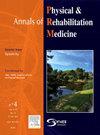Outdoor walking exercise therapy improves walking capacity and well-being in persons with multiple sclerosis: A randomized controlled trial
IF 4.6
3区 医学
Q1 REHABILITATION
Annals of Physical and Rehabilitation Medicine
Pub Date : 2025-04-18
DOI:10.1016/j.rehab.2025.101985
引用次数: 0
Abstract
Background
While outdoor walking exercise therapy could likely elicit multiple beneficial effects in persons with multiple sclerosis (pwMS), little evidence exists.
Objective
To evaluate the effects of a 7-week group-based outdoor walking exercise therapy intervention on walking capacity and mental well-being as well as additional outcomes in pwMS.
Methods
In this randomized controlled trial, n = 62 ambulatory pwMS (49/62, 79% females; 51 years [range, 27–68 years]), patient-determined disease steps 1.7 (range, 0–4) were assigned to either a WALK group (a ‘personalized’ program suited to the starting level of each participant, including one continuous and one intermittent supervised walking session per week at moderate-to-high intensity) or a CONTROL group (continuation of habitual lifestyle). Tests were carried out at baseline (Pre) and after the intervention (Post). Walking capacity included 6-minute walk test (6MWT; primary outcome), timed 25-foot walk test (T25FWT), and six spot step test (SSST). Walking fatigability indexes were calculated from 6MWT data. Patient-reported outcomes included 12-item MS Walking Scale (MSWS), modified fatigue impact scale (MFIS), 7-item falls efficacy scale-international (FES-I), World Health Organization five well-being index (WHO5; main secondary outcome), and 0–100 visual analogue scale health-related quality of life (HR-QoL).
Results
Across the 7-week intervention period, n = 17 (5/17, 27%) pwMS dropped out. No adverse events were reported. Across all WALK sessions, 78% of the time was spent on forest/gravel trails. Substantial between-group changes were observed (beneficial changes in WALK vs no changes in CONTROL) in 6MWT (mean change [95% CI]; +41 m [22;60]; deemed clinically relevant), T25FWT (+0.27 [0.15;0.39] m/s), SSST (-0.80 [-1.33;-0.27] s), WHO5 (+7.3 [0.1;14.5] points), MSWS (-5.1 [-9.2;-1.0] points), MFIS (-6.7 [-11.7;-1.7] points), FES-I (trend; -0.8 [-1.7;0.1] points), and HR-QoL (trend; +5.3 [-2.3;12.9] points). In contrast, walking fatigability indexes remained unaffected.
Conclusions
Outdoor walking exercise therapy elicited multiple beneficial effects in pwMS, especially evidenced by improvements in walking capacity and mental well-being.
Trial registration
ClinicalTrials.gov identifier NCT05415956.
户外步行运动疗法改善多发性硬化症患者的行走能力和幸福感:一项随机对照试验
虽然户外步行运动疗法可能会对多发性硬化症(pwMS)患者产生多种有益影响,但证据很少。目的评价为期7周的户外步行运动治疗干预对pwMS患者行走能力、心理健康状况及其他预后的影响。方法在本随机对照试验中,n = 62例动态pwMS患者(49/62,女性79%;51岁[范围,27-68岁]),患者确定的疾病步骤1.7(范围,0-4)被分配到WALK组(适合每个参与者起始水平的“个性化”计划,包括每周一次中至高强度的连续和间歇步行)或对照组(继续习惯生活方式)。在基线(前)和干预后(后)进行测试。步行能力包括6分钟步行测试(6MWT;主要结果)、定时25英尺步行测试(T25FWT)和6点步测试(SSST)。步行疲劳指数根据6MWT数据计算。患者报告的结局包括12项MS步行量表(MSWS)、改良疲劳影响量表(MFIS)、7项国际跌倒功效量表(FES-I)、世界卫生组织五项幸福指数(WHO5;主要次要结局)和0-100视觉模拟量表健康相关生活质量(HR-QoL)。结果在7周的干预期内,n = 17 (5/17, 27%) pwMS退出。无不良事件报告。在所有的WALK项目中,78%的时间花在森林/砾石小径上。在6MWT中观察到实质性的组间变化(WALK组有益变化vs对照组无变化)(平均变化[95% CI];+41 m [22;60];认为临床相关),T25FWT (+ 0.27 [0.15, 0.39] m / s), SSST(-0.80[-1.33, -0.27]年代),WHO5(+ 7.3(0.1, 14.5)点),”(-5.1[-9.2,-1.0]点),小额信贷机构(-6.7[-11.7,-1.7]点),FES-I(趋势;-0.8[-1.7;0.1]分),HR-QoL(趋势;+5.3[-2.3;12.9]分)。相比之下,步行疲劳指数没有受到影响。结论户外步行运动治疗对pwMS患者有多种有益作用,尤其是对行走能力和心理健康的改善。临床试验注册clinicaltrials .gov识别码NCT05415956。
本文章由计算机程序翻译,如有差异,请以英文原文为准。
求助全文
约1分钟内获得全文
求助全文
来源期刊

Annals of Physical and Rehabilitation Medicine
Medicine-Rehabilitation
CiteScore
7.80
自引率
4.30%
发文量
136
审稿时长
34 days
期刊介绍:
Annals of Physical and Rehabilitation Medicine covers all areas of Rehabilitation and Physical Medicine; such as: methods of evaluation of motor, sensory, cognitive and visceral impairments; acute and chronic musculoskeletal disorders and pain; disabilities in adult and children ; processes of rehabilitation in orthopaedic, rhumatological, neurological, cardiovascular, pulmonary and urological diseases.
 求助内容:
求助内容: 应助结果提醒方式:
应助结果提醒方式:


